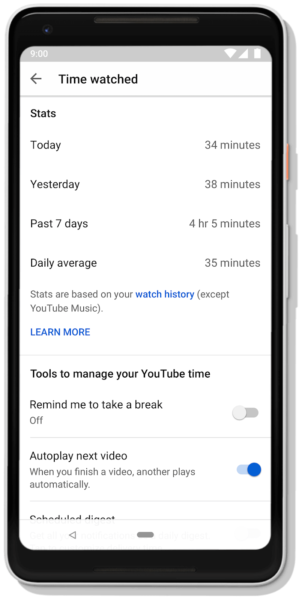YouTube gives users more ways to track the amount of time they spend on the app
YouTube profiles will now include a breakdown of how much time a user has spent watching videos during the past day, two days and week.

YouTube is rolling out more features designed to help users “take charge” of their digital well-being. Starting today, the ‘Watch History’ screen within a YouTube profile’s account will show how much time the user has spent on the app that day, the previous day and over the past seven days.
This latest feature comes a month after YouTube released the option for users to set a timer that would remind them to take a break from the app, something it had already been offering in the YouTube Kids app.
Here’s how YouTube’s latest feature displays time spent on the app:

YouTube is one of many platforms giving momentum to the industry-wide time well-spent movement, an initiative that aims to help people reduce the amount of time they spend looking at their phones and scrolling through their social media feeds. Apple and Google both announced a range of functions designed to help users monitor the amount of time they spend on their iOS and Android devices.
At the beginning of July, Instagram released a “You’re all caught up” message to notify users when they have seen every post in their feed from the last 48 hours. A month later, Facebook announced it would be rolling out activity dashboards for both Facebook and Instagram where users could track the amount of time they spend on the apps. In fact, Facebook CEO, Mark Zuckerberg, joined the digital well being bandwagon at the very start of this year when he wrote that his New Year’s resolution was to make sure the time people spend on Facebook was time well spent.
On the surface, encouraging people not to look at their phones or to detach themselves from their social apps wouldn’t seem to bode well for ad campaigns on apps like YouTube or Instagram. But, if a platform is better curating a user’s feed to create a more meaningful experience, there’s an argument to be made that the time well-spent movement could boost ad engagement. On the other hand, less time spent on a platform could mean fewer opportunities for advertisers to connect meaningfully with users, and advertisers may have to adjust expectations.
It will take more time for marketers and advertisers — and the app developers — to know how much of an impact the time well-spent movement will have on the ad economy, if any. For most brands, the bigger concern right now is how Google, Facebook and Twitter can continue to offer comprehensive ad targeting tactics while also keeping their platforms safe from bad actors and malicious content.
Contributing authors are invited to create content for MarTech and are chosen for their expertise and contribution to the martech community. Our contributors work under the oversight of the editorial staff and contributions are checked for quality and relevance to our readers. MarTech is owned by Semrush. Contributor was not asked to make any direct or indirect mentions of Semrush. The opinions they express are their own.
Related stories